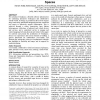Free Online Productivity Tools
i2Speak
i2Symbol
i2OCR
iTex2Img
iWeb2Print
iWeb2Shot
i2Type
iPdf2Split
iPdf2Merge
i2Bopomofo
i2Arabic
i2Style
i2Image
i2PDF
iLatex2Rtf
Sci2ools
UIST
2010
ACM
2010
ACM
TwinSpace: an infrastructure for cross-reality team spaces
We introduce TwinSpace, a flexible software infrastructure for combining interactive workspaces and collaborative virtual worlds. Its design is grounded in the need to support deep connectivity and flexible mappings between virtual and real spaces to effectively support collaboration. This is achieved through a robust connectivity layer linking heterogeneous collections of physical and virtual devices and services, and a centralized service to manage and control mappings between physical and virtual. In this paper we motivate and present the architecture of TwinSpace, discuss our experiences and lessons learned in building a generic framework for collaborative cross-reality, and illustrate the architecture using two implemented examples that highlight its flexibility and range, and its support for rapid prototyping. Author Keywords Cross-reality, collaborative virtual environment, tuplespace, RDF, interactive room, smart room, ontology, virtual world. ACM Classification Keywords H5.3....
| Added | 15 Feb 2011 |
| Updated | 15 Feb 2011 |
| Type | Journal |
| Year | 2010 |
| Where | UIST |
| Authors | Derek F. Reilly, Hafez Rouzati, Andy Wu, Jee Yeon Hwang, Jeremy T. Brudvik, W. Keith Edwards |
Comments (0)

